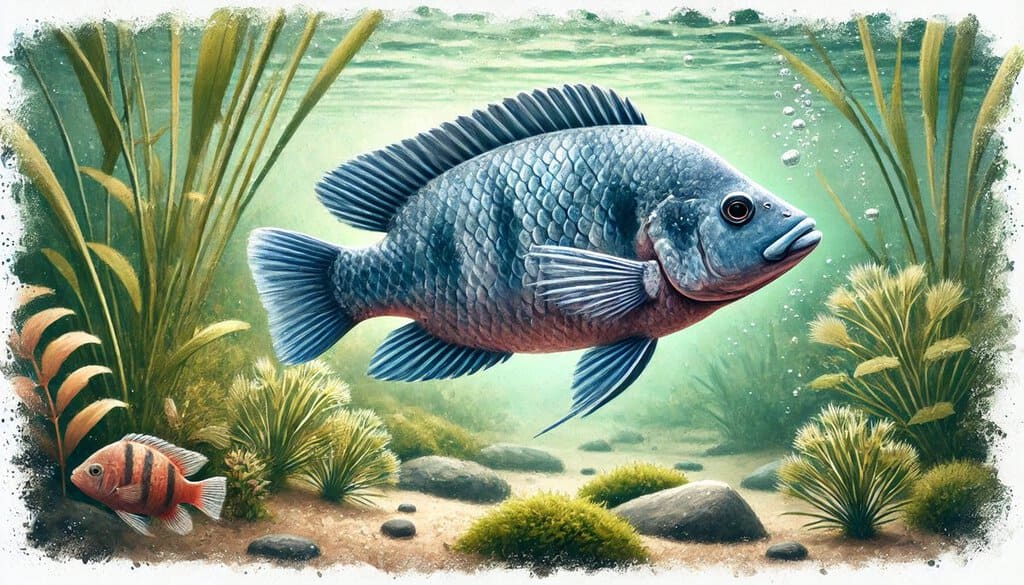Blue Tilapia (Oreochromis aureus) is a popular choice for aquaponics systems due to its resilience, fast growth rate, and adaptability to various water conditions. This species is particularly valued for its ability to thrive in cooler temperatures compared to other tilapia varieties, making it suitable for a wider range of climates[1][2].
Natural Habitat and Behavior
Origin and native environment: Blue Tilapia originates from Africa and the Middle East, naturally inhabiting rivers, lakes, and small water bodies[1].
Natural behavior in the wild: These fish are known to gather in schools and often invade spring runs during winter for warmth. They are territorial during breeding seasons and can be aggressive in defending their nests[1].
Temperament: In aquaponics systems, Blue Tilapia can be territorial, especially during breeding. They may become aggressive towards other fish when protecting their spawning areas[1]. Keep male-only tanks for lower aggression and faster growth.
Compatibility: While Blue Tilapia can be kept with other species, their territorial nature during breeding should be considered. They are generally more suited to single-species setups in aquaponics systems.
Water Requirements
Temperature Range:
- Ideal temperature: 20-22°C (68-71°F)[4]
- Can survive in temperatures as low as 8.3°C (47°F), making them more cold-tolerant than other tilapia species[2]
pH Level:
- Optimal pH range: 6.0-8.0[2]
- Can tolerate a wide range of pH levels, but stability is key
Oxygen Levels:
- Require well-oxygenated water
- Tolerant of lower oxygen levels compared to some other fish species
Ammonia/Nitrate Sensitivity:
- Sensitive to high ammonia and nitrate levels
- Regular water testing and maintenance of the biofilter are crucial
Tank or Pond Setup
Tank/Pond Size Requirements:
- Minimum 100 gallons (378 liters) for a small group[3]
- Allow approximately 10 gallons (38 liters) per adult fish
Filtration & Aeration:
- Require good filtration and aeration
- Bell siphon systems work well for maintaining water quality[3]
Lighting Considerations:
- Require a balance of light and dark periods
- 12-14 hours of light per day is typically sufficient[3]
Feeding Requirements
Diet:
- Omnivorous, but primarily herbivorous as adults
- Young tilapia eat a more varied diet, including small crustaceans and invertebrates[1]
Feeding Techniques:
- Feed 2-3 times daily
- Commercial tilapia feed is recommended for balanced nutrition
- Can supplement with algae and plant matter from the aquaponics system
Growth and Reproduction
Breeding Behavior:
- Mouthbrooders, with females incubating eggs in their mouths
- Spawn year-round, with peak activity from January to May
- Females lay 160-1600 eggs per spawning cycle[1]
Care of Fry:
- Fry are cared for by the female for 6-10 days after hatching
- Once released, fry should be separated from adults to prevent predation
- If you choose to have fry in your main tank, add lots of hiding places for them to escape the adults.
Harvesting & Culinary Considerations
Growth to harvest:
- Can grow from 2.5 cm (1 inch) fingerlings to 12.7-17.8 cm (5-7 inches) in a few months[3]
- Can reach harvest size of 0.45-0.9 kg (1-2 pounds) in 4-6 months under optimal conditions
Culinary Uses:
- Mild, white flesh suitable for various cooking methods
- Popular in many cuisines worldwide
Pros and Cons in Aquaponics Systems
- Tolerant of cooler temperatures
- Fast growth rate
- Efficient at consuming algae, helping to maintain water quality[1]
- Can become invasive if released into natural waterways
- Does require separate breeding tanks for optimal management and success
Common Health Issues and Solutions
Potential Diseases:
- Susceptible to common fish diseases like ich and fin rot
- Stress from poor water quality can lead to health issues
Treatment Recommendations:
- Maintain optimal water quality through regular testing and system maintenance
- Quarantine new fish before introducing them to the main system
Maintenance Tips for Long-Term Health
Maintenance Frequency:
- Regular water testing (at least weekly)
- Monitor temperature and oxygen levels daily
Handling Practices:
- Minimize handling to reduce stress
- Use nets with fine mesh to avoid damaging fins
Closing Thoughts
Blue Tilapia is an excellent choice for aquaponics systems, particularly in regions with cooler climates. Their adaptability, fast growth rate, and tolerance for various water conditions make them suitable for both beginners and experienced aquaponics practitioners. However, careful management of breeding and potential invasiveness is crucial for long-term success.
External sources:
[1] https://bassonline.com/freshwater-species/blue-tilapia/
[2] https://lakewaytilapia.com/live_tilapia_selection_guid.php
[3] https://freestylefarm.ca/2012/12/06/basement-aquaponics-and-raising-tilapia/
[4] https://www.howtoaquaponic.com/fish/tilapia-aquaponics/
[5] https://www.aquaponicsusa.com/ap-info/aquaponics-fish.html

